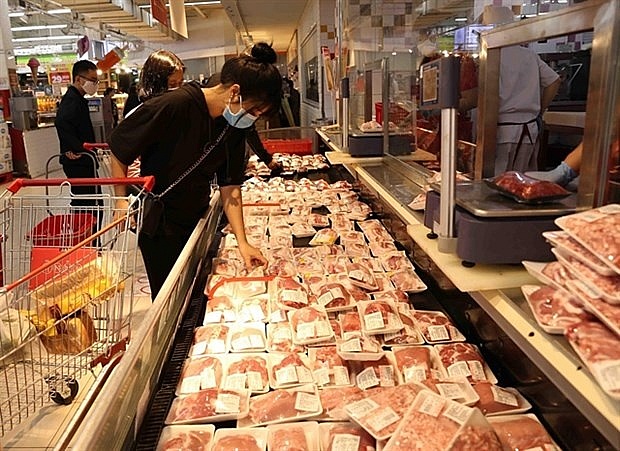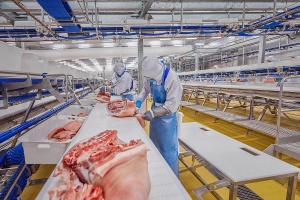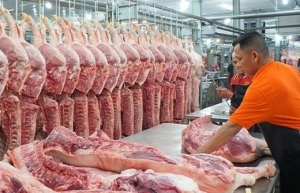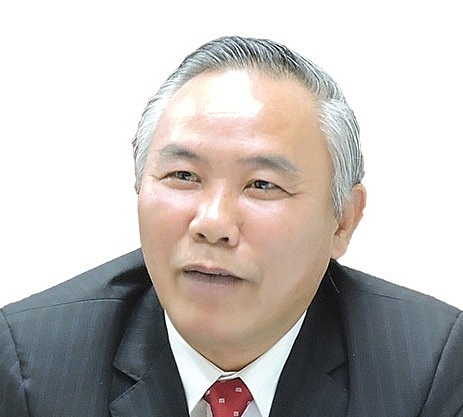Market attempts to stabilise pork prices
The price of pork in Vietnam in August so far has increased by more than VND10,000 (43 US cents) per kg as compared to last year while livestock production has decreased significantly.
BaF Vietnam is one of the businesses benefiting from the recent increase in hog prices. The high net profit margin from the livestock segment is clearly visible in the company’s current profit plan.
Phan Ngoc An, deputy general director of BaF, said that the increase in prices will promote the plan to sell about 259,000 pigs to the market this year.
BaF expects its net profit to increase by 25 per cent to $17.4 million, with about 73 per cent coming from the livestock segment.
 |
| Vietnam imported about 70,000 tonnes of pork and pork products in the first six months of 2021. (Source: VNA) |
The upward trend in meat prices has been reflected in stock price increases in the last week of July. Dabaco Group’s ticker went up 60 per cent, Hoang Anh Gia Lai’s increased by 45.5 per cent, and BaF’s rose 22.2 per cent.
Altogether, stocks of meat producers are trading at even higher levels than between June and December 2019 when hog prices also increased.
Between mid-June to July 27, pork prices increased by 19.9 per cent over the previous month and 38.6 per cent compared to the beginning of the year, especially in the north.
The government is closely monitoring pork price movements amid rising inflationary pressures. Prime Minister Pham Minh Chinh on July 31 requested to strengthen measures to stabilise pork prices and promote production to ensure supply.
Hoang Trong Thuy, an independent agricultural policy analyst in Vietnam, said that the price increases were due to supply shortage in some provinces thanks to African swine fever (ASF) in the first quarter, rising pig prices in China, and rising feed costs. “Vietnam’s agricultural market is always sensitive to factors coming from China,” Thuy said.
According to China’s National Development and Reform Commission, as of the week ended July 1, hog prices in the country had increased by 46 per cent compared to March. Pork prices, which rose nearly 3 per cent in June from May, also added to the country’s inflationary pressures.
“Considering the impact of the pig price increase in China on the Vietnamese market, cultural factors should be taken into account,” Thuy said.
Two months before the Mid-Autumn Festival is typically the time when Chinese businesses increase their purchases of pork from here for mooncakes. The geographical advantage also provides greater added value for Chinese buyers, as logistics costs are lower than in other countries, such as Brazil, Canada, the EU and the United States.
A new pork price hike is expected by the Chinese side, but Thuy said, “Prices will not spike considering how the Chinese government stabilises prices.”
China has national reserves for pork, though nobody seems to know the volume of these. Last month, the Chinese government said it was considering exploiting the national strategic pork reserve to prevent prices from rising rapidly and, at the same time, prevent price manipulation from livestock farms.
Thuy noted that China’s pork production continued to increase, despite the sharp increase in meat prices in the domestic market. China’s pork production in the second quarter of 2022 increased to 13.78 million tonnes, reaching a multi-year high as the herd recovered from ASF according to data from China’s National Statistics Office.
In Vietnam, rising pork prices have begun to impact the livestock industry in recent weeks.
Nguyen Kim Doan, vice chairman of the Dong Nai Breeding Association, said that the price of live pigs is around $2.8 per kg. “This has not been a driving force to motivate farmers to reorganise their herds,” Doan said.
The average live hog price in August 2021 was about $2.39 per kg, much lower than the high average of $3.50 in 2020.
Dong Nai, the southern province with the largest pig production in the country, currently has only around 6,100 smaller pig-raising households, a decrease of thousands compared to the period of time before the outbreak of ASF, according to Dong Nai Department of Agriculture and Rural Development.
“The number of pig-raising households continues to decrease. Hopefully, the pork price will increase further to partially offset the cost for farmers,” Doan said.
| Phung Duc Tien, Deputy Minister of Agriculture and Rural Development
At present, the price of live hogs is stable around $3 per kg, which means that localities should promote re-herding and ensure a growth rate of about 4.8 per cent of their pig herds for the whole year, also to ensure the supply of pork for Lunar New Year. Currently, the price of pigs from the farm to the dining table is about 1.5-1.7 times different. The Ministry of Agriculture and Rural Development will try to adjust the price development, so that consumers and farmers will benefit from this, rather than being negatively affected by the consumer price index. By the end of July, the national pig herd reached 28 million heads, an on-year increase of 4.8 per cent. It is expected that this year, the whole country will reach more than seven million tonnes of meat of all kinds, from pigs, buffaloes, cows, and chickens, ensuring food supply until the end of the year, especially during Lunar New Year. In 2021, meat production of all kinds reached 6.69 million tonnes. |
| China is the world’s largest meat consumer. The US Department of Agriculture expects that by the end of 2022, Chinese people will eat more than 53 million tonnes of pork, as well as 10 million tonnes of beef and veal. Vietnam will rise to the second position in Asia (after China) in terms of pork consumption in 2022, with a figure of about 3.4 million tonnes. The annual growth rate is expected to be around 3.1 per cent during 2022-2030, according to a forecast by the Organisation for Economic Co-operation and Development. Pork consumption of Vietnamese people is less than five or six years ago. In 2018, each Vietnamese person consumed an average of 31.4kg of pork. By 2022, the figure decreased to 23.5kg, according to data announced by market researcher Ipsos in June. |
 | Vietnam's pork industry faces shrinking consumption and domestic supply Vietnam's pork industry is growing slowly due to the decrease in consumption and domestic supply, posing enormous challenges for farmers. |
 | Government orders immediate measures to stabilise pork prices In light of the rising price of pork and feed ingredients in recent times, Deputy Prime Minister Le Minh Khai has asked relevant authorised agencies to take immediate measures to ensure supply and demand and stabilise prices. |
What the stars mean:
★ Poor ★ ★ Promising ★★★ Good ★★★★ Very good ★★★★★ Exceptional
 Tag:
Tag:
Related Contents
Latest News
More News
- Dat Bike accelerates sustainable mobility (January 07, 2026 | 15:24)
- Innovation to support modern healthcare development (January 07, 2026 | 10:00)
- Six localities record double-digit growth as regional performance diverges in 2025 (January 06, 2026 | 18:00)
- E-commerce market undergoes transformation amid rising competition and regulation (January 06, 2026 | 17:54)
- Vietnam’s industrial output hits seven-year high in 2025 (January 06, 2026 | 17:47)
- GELEX’s credit rating outlook upgraded to 'Positive' by VIS Rating (January 06, 2026 | 16:49)
- Finance sector lays firm groundwork for 2026 after major reform (January 06, 2026 | 15:30)
- Vietnam’s seafood exports surpass $11 billion in 2025 (January 06, 2026 | 08:51)
- Vietnam GDP posts second-strongest growth since 2011 (January 06, 2026 | 08:35)
- Double-digit GDP growth within reach with shift to higher-value expansion (January 06, 2026 | 08:33)























 Mobile Version
Mobile Version